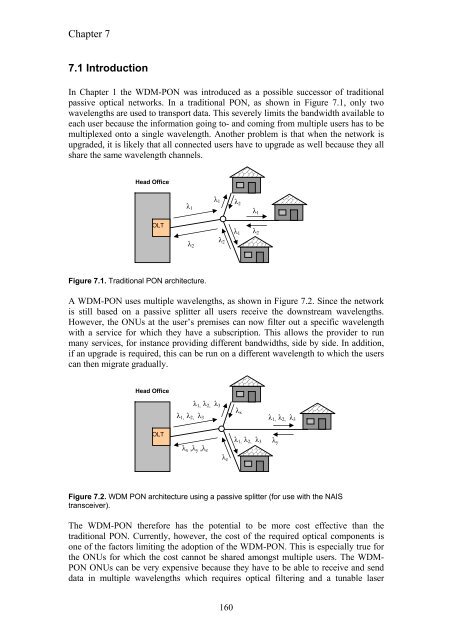Edwin Jan Klein - Universiteit Twente
Edwin Jan Klein - Universiteit Twente
Edwin Jan Klein - Universiteit Twente
You also want an ePaper? Increase the reach of your titles
YUMPU automatically turns print PDFs into web optimized ePapers that Google loves.
Chapter 7<br />
7.1 Introduction<br />
In Chapter 1 the WDM-PON was introduced as a possible successor of traditional<br />
passive optical networks. In a traditional PON, as shown in Figure 7.1, only two<br />
wavelengths are used to transport data. This severely limits the bandwidth available to<br />
each user because the information going to- and coming from multiple users has to be<br />
multiplexed onto a single wavelength. Another problem is that when the network is<br />
upgraded, it is likely that all connected users have to upgrade as well because they all<br />
share the same wavelength channels.<br />
Head Office<br />
OLT<br />
Figure 7.1. Traditional PON architecture.<br />
A WDM-PON uses multiple wavelengths, as shown in Figure 7.2. Since the network<br />
is still based on a passive splitter all users receive the downstream wavelengths.<br />
However, the ONUs at the user’s premises can now filter out a specific wavelength<br />
with a service for which they have a subscription. This allows the provider to run<br />
many services, for instance providing different bandwidths, side by side. In addition,<br />
if an upgrade is required, this can be run on a different wavelength to which the users<br />
can then migrate gradually.<br />
Head Office<br />
OLT<br />
λ1<br />
λ2<br />
λ1, λ2, λ3<br />
λ1, λ2, λ3<br />
λx ,λy ,λz<br />
λ1 λ2<br />
Figure 7.2. WDM PON architecture using a passive splitter (for use with the NAIS<br />
transceiver).<br />
λ2<br />
λz<br />
The WDM-PON therefore has the potential to be more cost effective than the<br />
traditional PON. Currently, however, the cost of the required optical components is<br />
one of the factors limiting the adoption of the WDM-PON. This is especially true for<br />
the ONUs for which the cost cannot be shared amongst multiple users. The WDM-<br />
PON ONUs can be very expensive because they have to be able to receive and send<br />
data in multiple wavelengths which requires optical filtering and a tunable laser<br />
160<br />
λ1<br />
λx<br />
λ1<br />
λ2<br />
λ1, λ2, λ3<br />
λ1, λ2, λ3<br />
λy















